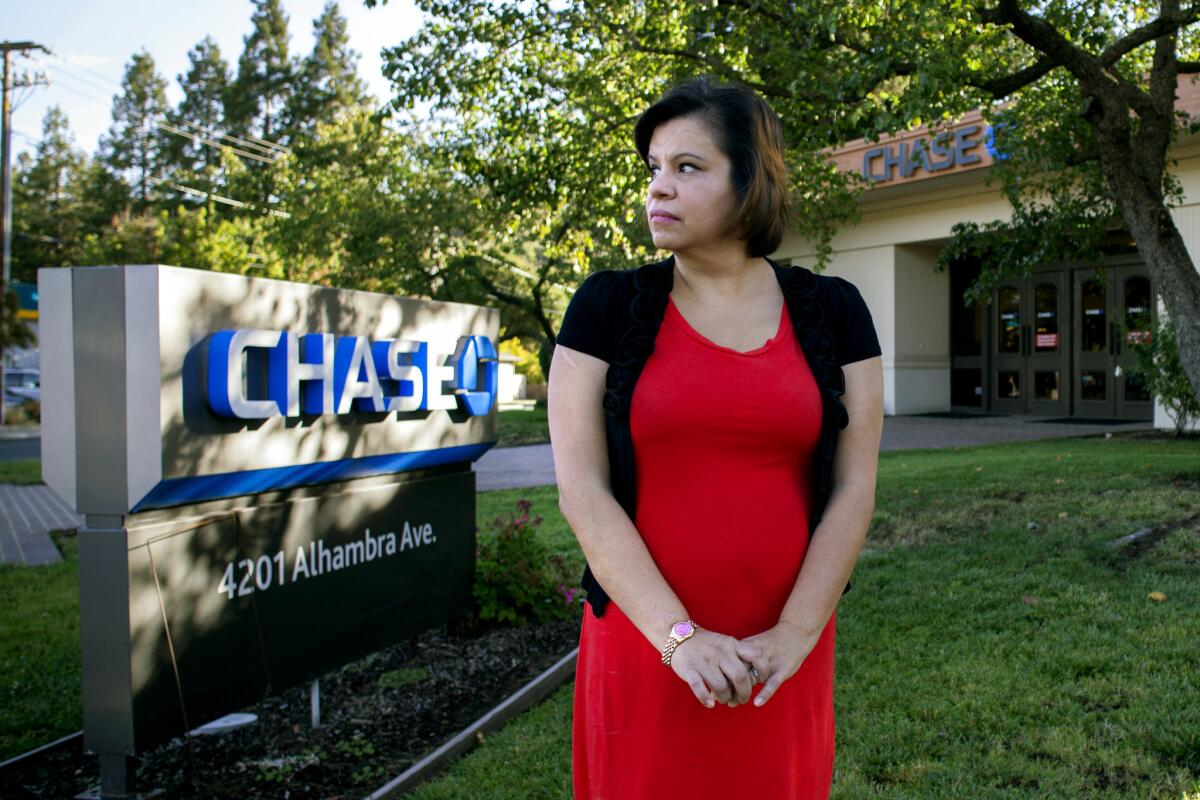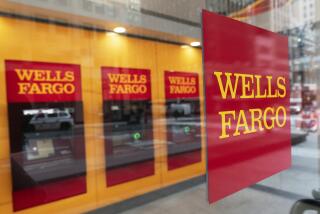How Wells Fargo’s rivals make it harder for employees to create fake accounts

- Share via
For Estela Slikker, life as a personal banker at a Chase branch in the East San Francisco Bay city of Martinez wasn’t easy.
She worked long hours trying to open enough accounts to meet her monthly sales goals and earn bonuses that could more than double her minimum-wage pay.
After a fight with her boss, though, she had enough.
Slikker quit and headed to rival Wells Fargo & Co., but once there found something even more unpleasant — far tougher sales goals and co-workers who had figured out how to meet them by gaming a flawed incentive system.
The situation at Wells Fargo “was 10 times or 20 times worse,” she said.
“At Chase, they were more interested in getting money from people — getting deposits. With Wells Fargo, they just cared about how many accounts you opened. That’s where it started with all those employees doing fraudulent activities,” said Slikker, who worked for Chase in 2011 and at Wells Fargo for two years after that.
The revelation last month that Wells Fargo employees, trying to meet onerous sales goals, created as many as 2 million unauthorized savings, checking and credit card accounts has created a huge scandal for the San Francisco-based institution.
But it’s also prompted calls for a wide-ranging investigation into the banking industry, where sales goals are common and complaints of unauthorized accounts have been lodged against other banks.
At a recent Capitol Hill hearing during which Wells Fargo Chief Executive John Stumpf was pilloried, Rep. Brad Sherman (D-Porter Ranch) said he’d like top executives from all the nation’s big banks to testify before the House Financial Services Committee about whether workers at other institutions have created bogus accounts.
Executives at other large banks, speaking to The Times on the condition of anonymity because they do not have permission to speak about the issue, say it’s a near certainty that some workers have created unauthorized accounts at their institutions. Banking consultant Margaret Kane agreed.
“All organizations with sales goals are going to be susceptible to falsified sales records,” said Kane, who worked at Wells Fargo in the 1980s and ’90s before founding Kane Bank Services, which focuses on bank sales practices.
A review of complaints submitted to the federal Consumer Financial Protection Bureau shows that from late 2011 to Sept. 7 of this year — the day before the Wells Fargo settlement was announced, throwing a spotlight on the issue of unauthorized accounts — more than 1,300 consumers lodged complaints that were catagorized as credit cards issued for them without authorization.
Many of those complaints, though, seem to instead detail other problems, such as credit card billing disputes or possible identity theft — not the kind of unauthorized account creation that regulators say was widespread at Wells Fargo.
Kane said she expects regulators will find fewer problems at other institutions.
Kane once consulted for a bank that had a branch just down the street from a Wells Fargo location. Her client’s branch had a goal of opening 300 new accounts each quarter — the Wells Fargo branch had a goal of more than 7,500.
“They were way outside of what reasonable expectations should have been,” she said.
That was Slikker’s experience too. She said that compared with her old Chase branch in Martinez, the Wells Fargo branches in Lafayette and Moraga where she worked had less foot traffic, yet there were more bankers on staff, and the sales goals were higher.
Another key difference: At Chase, Slikker had monthly sales goals, while at Wells Fargo the goals were broken down into daily increments, creating huge tension in the branch.
“At Chase, it didn’t matter if I went one day without any accounts — it wasn’t a big deal,” she said. “At Wells Fargo, it was per day. At the end of the day, the manager had to report how many accounts he had. And I think he really got yelled at if he didn’t have the numbers. So then he, in turn, would turn around and scream at us.”
Slikker said that she never created unauthorized accounts, but that a Wells Fargo co-worker opened two such accounts in the name of Slikker’s teenage daughter. Given how badly employees wanted to avoid a scolding, she wasn’t surprised.
“I think a lot of people were just trying to keep their jobs and trying to keep managers away from them,” she said.
Workers at Wells Fargo also found that they could meet those aggressive goals by gaming the system, something harder to do at Chase and other banks.
Chase bankers would only get credit for opening a single checking or savings account for an individual customer, even if the customer for some reason wanted multiple checking accounts. At Wells Fargo, such a scenario would credit a worker with multiple accounts, Slikker said.
Similarly, Chase workers would not get credit for opening a savings account unless customers deposited several hundred dollars into the account within a few months, she said.
Patricia Wexler, a JP Morgan Chase spokeswoman, said the deposits must total at least $1,000 within 60 days. The money also had to be new to the bank and not transferred from another Chase account.
At Wells Fargo, workers could get credit for opening a savings account once a minimum deposit of $25 was made, even if that money came from another Wells Fargo account and even if the account sat unused afterward.
The Consumer Financial Protection Bureau, one of the federal regulators that investigated the unauthorized accounts, found that Wells Fargo workers routinely transferred money from customers’ legitimate accounts into unauthorized ones so they could “obtain credit under the incentive-compensation program.”
Ruth Landaverde, who worked for Wells Fargo in 2009 and 2010 and then for Bank of America from 2010 until last year, noted similar distinctions between sales practices at those two banks.
At Bank of America, workers only got credit for checking accounts that were still open and had a balance of at least $100 three months later, she said. Others at the bank said employees only get full sales credit for accounts that remain active — not just open — for seven months.
Another distinction: At Bank of America, when a customer opened a credit card account, Landaverde said, it wouldn’t count toward her sales goal until the customer started using the card. Wexler said the same is true at Chase. Not so at Wells Fargo.
“With them, you would get your points as soon as it was issued. They were more like, ‘Just get the card to them,’ ” recalled Landaverde, now a member of the Committee for Better Banks, a union-backed group trying to organize bank workers and pushing banks to eliminate sales goals.
Wells Fargo spokeswoman Mary Eshet said the bank’s sales system used “a number of different metrics that … evolved over time,” and that, as at other banks, workers could lose credit for opening accounts that were not used.
But Wells Fargo workers, including a former district manager and a current branch manager, say information about account activity was sometimes ignored and that most front-line workers were focused only on meeting their daily sales goals, not on whether customers were using their accounts months later.
The branch manager, who asked that his name be withheld because he fears he would fired for speaking to the media, said the bank has taken account activity reports more seriously only in the last few years.
Even if sales goals don’t push employees to open unauthorized accounts, the Committee for Better Banks and some consumer advocates argue goals and quotas, which are widespread in the industry, can encourage workers to push customers into products they don’t need and that could be financially harmful.
Landaverde, for instance, said that her manager at Bank of America encouraged workers to call new credit card customers and urge them to start making purchases — a practice she believes is unethical and encourages unnecessary debt.
Bank of America declined to comment on the specifics of its sales practices, but spokeswoman Anne Pace said the bank’s business and its incentive-compensation system are “based on maintaining a straightforward, transparent and fair relationship with our customers.”
Amid the heightened attention on the issue, regulators in Massachusetts this week filed a lawsuit against Wall Street investment bank Morgan Stanley, saying it had sales incentives that pushed wealth managers to sell potentially risky loans to clients.
As regulators press on with their review of bank sales practices, and as members of Congress and other politicians continue to rail against Wells Fargo, Kane said she imagines many banks will change their sales systems and some may even get rid of goals tied to opening new accounts.
“I think banks are going to get really nervous about unit sales goals,” she said. “The inclination will be to overreact rather than to not react.”
Wells Fargo has already made big changes.
As of Oct. 1, the bank no longer has goals tied to product sales. For the rest of this year, Eshet said Wells Fargo will determine employees’ incentive pay based on customer satisfaction surveys as it works out a new incentive-compensation system.
Follow me: @jrkoren
MORE BUSINESS NEWS
After Wells Fargo’s beating on Capitol Hill, it could face local sanctions over accounts scandal
Mistakes to avoid when enrolling in benefits at work
HOA boards should think twice before taking a hard line on rules
More to Read
Inside the business of entertainment
The Wide Shot brings you news, analysis and insights on everything from streaming wars to production — and what it all means for the future.
You may occasionally receive promotional content from the Los Angeles Times.











